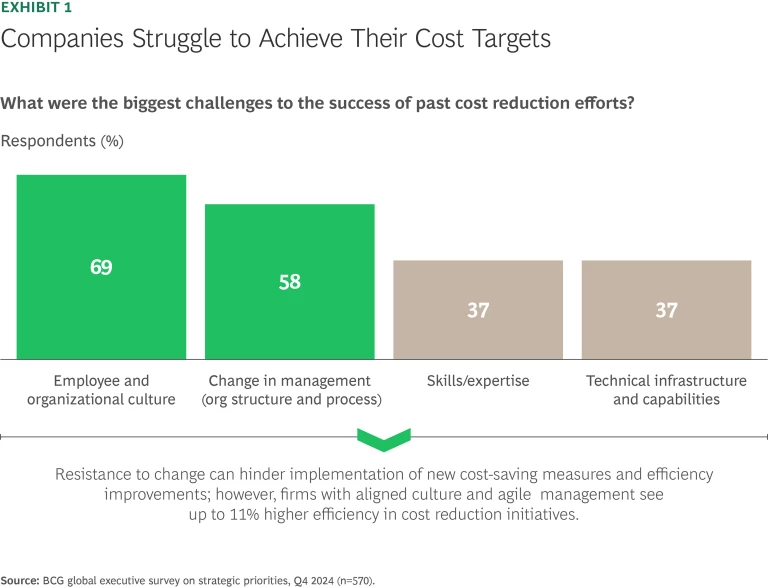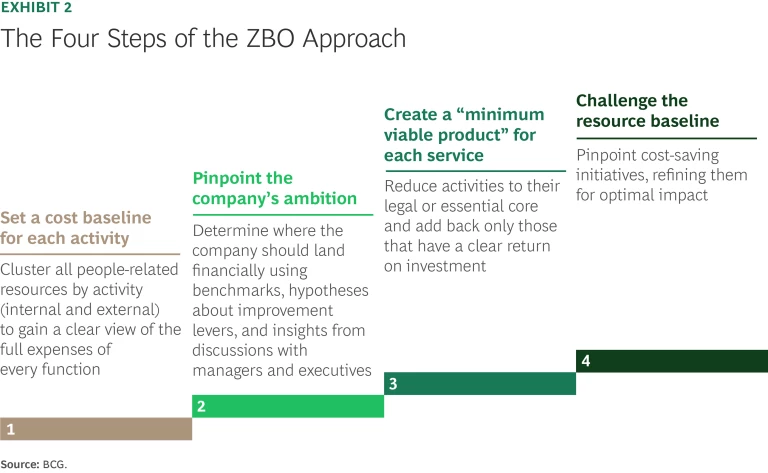In today’s volatile business environment—marked by inflation, geopolitical instability, and digital disruption—cost discipline is no longer optional. A BCG survey shows that one in three C-suite executives now ranks cost reduction as a top priority.
Yet traditional cost management approaches are falling short, especially when it comes to the biggest expense line: people. Personnel costs are notoriously complex to manage. CEOs must cut waste without damaging morale, losing critical talent, or undermining growth. This is where the zero-based organization (ZBO) comes in—a fresh, rigorous approach to sustainable cost transformation.
Why Traditional Cost Cutting Falls Short
Most companies urgently need to manage personnel costs, but deeply embedded structural and cultural barriers often stand in their way. Nearly seven in ten C-suite executives in BCG’s survey pinpointed employee and organizational culture as the biggest hurdle to effective cost management. (See Exhibit 1.) In this environment, top-down mandates frequently backfire, draining employee engagement, eroding ownership, and triggering resistance rather than results.

Stay ahead with BCG insights on corporate finance and strategy
Equally troubling, BCG’s discussions with C-suite leaders suggest that many companies undermine their efforts by chasing easier-to-execute savings instead of embracing real organizational transformation. They might move past the simplest cuts, yet still fail to fundamentally challenge costs across silos, units, and functions. Without a real willingness to redesign operations from the ground up, early savings quickly vanish, and costs inevitably creep back.
Our C-suite survey has some good news, too: companies that build cost discipline into their DNA—embedding it into their culture and governance—see up to 11% more efficiency in their cost reduction initiatives.
ZBO: Built for Today’s Cost Pressures
By enabling organizations to strategically right-size and reset, the ZBO approach addresses cost pressures more effectively than traditional methods. (See Exhibit 2.)

ZBO examines every activity at a granular level, differentiating between low-value spending (to be eliminated) and strategic investments (to be preserved or expanded). This bottom-up, evidence-based methodology fundamentally redesigns cost structures, rather than simply trimming existing budgets. Cost savings often reach 20% to 30%. The result is a leaner, more effective organization—one with the capabilities needed for future growth and sustained competitive advantage.
Five Problems Every CEO Faces—Solved by ZBO
In working with CEOs to improve their resource allocation and workforce costs without jeopardizing future competitiveness, we see them encounter the same five tough challenges, to which ZBO provides practical solutions.
1. We’ve reached the limit of our imagination—what’s left to cut? Many executives believe they’ve already exhausted all realistic savings opportunities. After capturing the easy ones, teams often lack the imagination or willingness to identify deeper efficiencies, in many cases believing that further reductions will damage performance. With financial pressures mounting, leaders are challenged to inspire teams to stretch their imaginations and uncover ways to break through silos, rethink workflows, and redesign organizational structures to unlock efficiencies without compromising capabilities.
The ZBO approach offers a fresh perspective by requiring organizations to rebuild cost structures from the ground up. Rather than layering new cuts on top of old systems, leaders conduct a data-driven reassessment to uncover hidden inefficiencies and address legacy spending. This fact-based methodology enables a strategic reallocation of resources and unlocks opportunities beyond gradual improvement savings.
For example, a fast-moving consumer goods company facing margin pressure undertook a granular, activity-level review across its functions to uncover previously overlooked savings. This detailed approach enabled it to identify opportunities for cost reduction while protecting areas already cut to the bare minimum in earlier initiatives. As a result, the company achieved significant, sustainable savings in a low-margin business, despite multiple prior cost-cutting rounds—without sacrificing top-line growth.
2. We need to grow—how do we cut costs without hurting our future? In seeking to reduce costs, companies sometimes slash spending in critical areas, unintentionally hurting their long-term competitiveness. Without a deliberate plan to preserve high-value spending, cost cutting can compromise an organization’s ability to innovate and adapt.
A ZBO approach prevents indiscriminate, across-the-board cost reductions, ensuring that funds are directed to high-value areas. It reallocates resources away from nonessential activities and toward strategic priorities—such as AI, automation, and talent development—fueling sustainable growth while maintaining cost discipline. By adopting a structured reinvestment framework, companies can optimize expenses without sacrificing their innovation momentum. As a result, they gain a foundation for ongoing competitiveness and resilience.
For example, a utility company needed to free up capital to invest in the transition to renewable energy and upgrade its support functions to better pursue growth opportunities. Instead of making blanket cuts, it used the ZBO approach to precisely target low-value-added SG&A spending while reallocating savings into strategic growth capabilities. Value identification initiatives across all major support functions uncovered net savings opportunities ranging from 10% to 25%. A bottom-up, data-driven approach ensured those savings were realistic, aligned with business needs, and sustainable over the long term.
3. Our people are burned out—how do we maintain morale? After multiple rounds of cost cutting, employees are often fatigued and skeptical about new efficiency mandates. Past initiatives may have increased administrative workloads and complexities without delivering meaningful benefits, leaving staff disengaged and wary of further measures. Without a clear plan to address these concerns and simplify processes, organizations risk alienating employees just when they need buy-in the most.
ZBOs mitigate this problem by engaging employees in pinpointing inefficiencies. A broad group participates in “challenger workshops” to find new cost-saving solutions, replacing the top-down approach with shared ownership. In addition, by streamlining or automating redundant tasks, the ZBO approach not only reduces bureaucracy but also demonstrates tangible improvements in day-to-day work. This inclusive, evidence-based methodology helps maintain morale. Employees see that any new measures focus on genuine productivity gains that make their jobs easier, rather than arbitrary cuts that add to their hours and frustration.
The most successful companies actually boost morale. A BCG survey found that while most companies report either no change or a decline in morale in response to cost programs, 62% of cost optimization pioneers—those that excel at meeting productivity and cost savings targets—report a positive impact.
At a pharmaceutical company, more than 200 employees—including budget owners, functional experts, and the internal consulting team—were directly involved in designing solutions through a series of challenger workshops. This resulted in strong ownership and broad-based support. Many of the savings came from targeting specification levers that preserved value while improving the efficiency of expenditures, enabling employees to “work smarter, not harder.” For example, the company standardized workflows with media agencies to avoid time-consuming, expensive iterations.
4. We can’t lose our top talent—how do we balance cuts and capabilities? Striking the right balance between reducing personnel costs and retaining essential talent is no easy feat. Indiscriminate headcount reductions can compromise core business functions, particularly when high-demand roles in AI and digital technology remain expensive to fill and critical to strategic objectives. As cost pressures escalate, companies often resort to short-term workforce cuts that eventually erode competitiveness, leaving them ill-prepared to execute growth initiatives.
A ZBO approach differentiates the specific roles, capabilities, and activities that drive real value. By mapping each position to distinct contributions, companies can eliminate low-impact tasks and redeploy staff while safeguarding critical expertise. This enables organizations to preserve core competencies, maintain operational readiness, and achieve sustainable cost efficiency—without sacrificing the talent needed to stay competitive.
To improve its talent management infrastructure, the utility company referred to above used a ZBO approach to reset its HR function with a demand-oriented lens. While many initiatives targeted efficiency, the company also pinpointed under-resourced areas where capability gaps impeded growth. This led to a strategic reinvestment in capabilities such as workforce planning, career management, and remuneration—ensuring a stronger pipeline of talent aligned with long-term business needs.
5. Our savings don’t stick—how do we make them last? More than one-third (35%) of leaders surveyed by BCG said that cost reduction measures fail to stick, with expenses creeping back over time. A lack of long-term cultural adoption is often to blame: when organizations do not embed cost-conscious behaviors into daily practices, they ultimately revert to previous spending patterns. To address these pitfalls, companies need to focus on the “how” as much as the “what” across all cost drivers.
ZBO programs promote sustained improvements by reimagining cost management as a continuous, strategic discipline rather than a one-time fix. First, they use a structured methodology—defining a “minimum viable product” for critical services—to eliminate legacy spending while aligning resources with strategic priorities. Second, they establish clear accountability. Business leaders must demonstrate the value of expenditures and systematically track results through service-level contracts and performance metrics, ensuring that cost efficiency remains a sustained competitive advantage. Finally, ZBO programs foster a cost-conscious company culture. Employees and leaders are encouraged to challenge and justify every expense, transitioning from the pursuit of short-term cost fixes to a long-term, strategic mindset.
For example, the pharmaceutical company referred to earlier sought sustainable reductions in indirect costs to improve profitability and fund growth. It introduced cost category owners to challenge budget proposals, trained a global team to support initiatives, and embedded execution capabilities into the organization. Governance and finance systems were updated to improve cost visibility and accountability. To promote cost consciousness and sustainability, ZBO champions were appointed to drive cultural change, ensure savings realization, and scale the approach across the company.
In an era when margin pressure often competes with growth ambition, ZBO offers a strategic edge. More than a finance initiative, it is a cultural shift that makes cost consciousness a permanent part of how the organization operates. For CEOs, the takeaway is clear: ZBO is not about saying “no” to spending—it is about saying “yes” to the right investments. Done well, it enables companies to get leaner, stay agile, and outperform the market.






